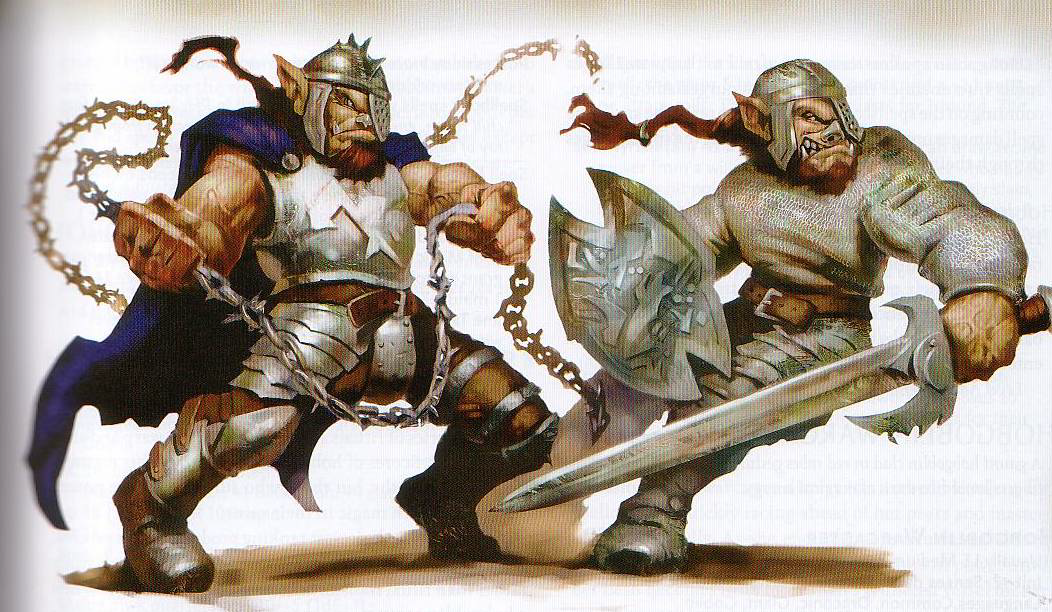Some sixth sense warned Agnarr of the threat. He began to turn, but it was late: The duskblade’s sword lashed out.
As I mentioned a few weeks back, one of the things I did while prepping this campaign was to do a survey of published modules (most notably a large swatch of Dungeon Magazine) looking for really cool scenarios that I could slot into the campaign.
Another survey I’ll do when prepping a new D&D campaign is a wide swath through my myriad bestiaries. This is something I’ve been doing since I was like eleven or twelve years old, and I find it really effective: There’s nothing like a well-written (and well-illustrated) bestiary to spur the imagination in unexpected directions, and one of the great things about 3rd Edition is that, with third party support, there’s never been a game with such a ridiculous wealth of such resources.
The stage where I’ll do my bestiary survey is generally after I’ve sketched in the broad strokes of the campaign: For example, I might know that a campaign is going to feature a lot of overland travel through a decaying empire; a delve into an abandoned dwarven city; some island-hopping in piratical waters; and then a journey through a portal into hell.
This focuses my attention: I’m not just looking for generically cool monsters; I’m specifically looking for stuff that will be useful (and also cool). The entire point, of course, is still to flesh out material in ways I hadn’t anticipated (which is how I discover that the abandoned dwarven ruins have been taken over by an expedition of dark dwarfs, perhaps), and I’m also hoping to be inspired to include truly unexpected dimensions to the campaign as a result of this material. But every survey ends up being different, even when it’s revisiting the same books, because with every survey I’m looking at the books through a different lens. It can actually be quite exciting to discover new aspects of a book simply by virtue of approaching it from a fresh angle.
This is where Ursaal and the caste of assassins known as the duskblades came from in this scenario: Ursaal is a hobgoblin warcaster from Monster Manual V, and the duskblades are hobgoblin duskblades from the same. I tagged the whole Hobgoblin section of that book as a potentially useful resource because it contained a number of stat blocks for hobgoblins with class levels, so it was easy to reach in and grab them as the need arised.
Wait a minute… hobgoblins? I thought these were goblins!
First, as I’ve mentioned before, I really won’t hesitate to use a stat block for one thing to model something else that it’s appropriate for. If I need to tweak one or two things to make it work, great. But more often than not, even that’s not necessary.
Second, and this is something I may discuss at greater length on some other occasion, I’ve never really gotten a lot of personal utility out of having ninety thousand largely indistinguishable humanoids wandering around. In fact, as a general principle of reincorporation, I find it much preferable to take disparate cultural elements and look at them as being different facets of a single race, rather than splitting every cultural distinction into a separate genetic pool.
In the case of the Western Lands campaign setting where my version of Ptolus is located, this translates to virtually every “bad guy humanoid” getting grouped into either the goblin race or the kobold race. (And why keep that distinction? Primarily because the latter are related to dragons, and that’s an important distinction for deeply ingrained historical reasons.) Even ogres are actually just really big goblins in this world.
The memetic gestalt of D&D being what it is, over time (and many, many campaigns) my “hard line” on this sort of thing has frayed a bit. Halflings, for example, were not originally part of the Western Lands, but they started creeping in when I had a player who cared far more passionately about playing a halfling than I cared about not having halflings in the setting. I had them living in isolated villages on the islands of the Teeth of Light; but once they existed at all it became easy enough to just leave them in situ when using published adventures. (This is particularly true in coastal regions near the Southern Sea, which includes Ptolus. So you’ll see a number of them popping up from time to time throughout these campaign journals.)
Ptolus has also seen ratfolk added to the tally of humanoids, as they are quite pervasive in Cook’s material. They have not yet escaped the confines of In the Shadow of the Spire, so time will tell whether or not they are truly permanent residents of the Western Lands, or merely strange visitors (perhaps the product of Ghul’s laboratories).













